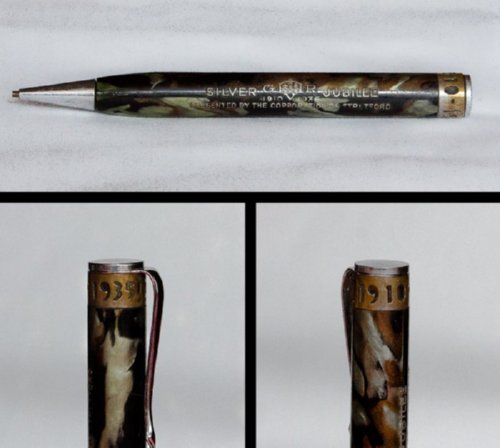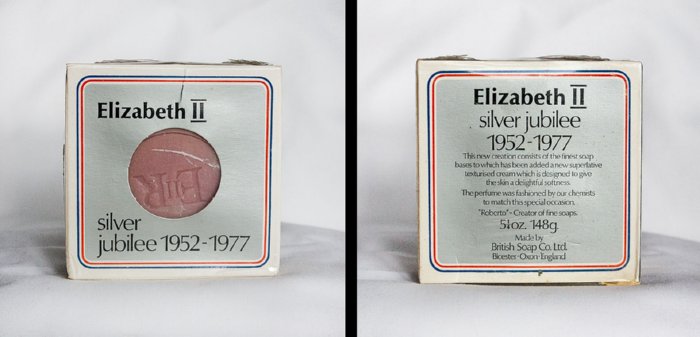
JUBILEE MUSEUM
A selection of Jubilee souvenirs (and other Royal items) from the
shelves of one
Photo 1

1935 Silver Jubilee mug (King George the Fifth and Queen Mary), issued
in the Parish of Braddan, in the Isle of Man.
The reverse shows the Old Kirk of Braddan, which ceased to be
used regularly in 1876, but which remains in occasional use, under the
care of the Friends of Old Kirk Braddan (founded 1982).
Evening Prayer is said on the 1st,3rdand 5th
Sundays of the month May to September.
A good view of the TT racecourse may be had from the graveyard.
The Old Kirk is one of the much-loved sites of the Manx people.
The image appeared recently on the 35p Manx Christmas stamp of
2010.
The base shows that the maker of the mug was the well-known pottery
manufacturer Wagstaff and Brunt, of the Richmond Pottery, Longton,
Stoke-on
Photo 2

1937 Coronation mug for King George the Sixth and Queen Elizabeth.
The mug bears the separate images of the King and Queen, each surrounded
by a gilt floral circlet.
His Majesty is surmounted by a gilt G, Her Majesty by a gilt E.
Between the circlets is the Imperial State Crown.
Beneath the circlets is the inscription GEORGE
CORONATION 1937
The reverse shows the young Princess Elizabeth.
The lip of the mug is lined in blue.
The foot of the mug carries a gold lining.
The base shows the mug to be made in
Photo 3

1977 Silver Jubilee Mug for
Queen Elizabeth the Second (our present Queen).
The mug depicts the Royal coat of arms, surrounded
by the Garter, surmounted by
Her Majesty’s Garter crest (a gold helmet crowned) with the traditional
supporters, the lion and the unicorn.
The reverse lists the Kings and Queens of
The base reveals that the mug was made by Aynsley (established 1775) of
fine bone china. Aynsley was
based in Longton, in
Photo 4

1977 Silver Jubilee mug for Queen Elizabeth.
The mug bears the Queen’s E II R cypher, Prince Philip’s garter badge
and the inscription THE QUEEN’S SILVER JUBILEE 1952-1977.
The base shows that the mug was made in
Photo 5

2002 Golden Jubilee mug by Jane Healey.
The mug shows Her Majesty, smiling, in a less formal pose, in a pink
dress. The crown is included
in a garland of the four national flowers.
The gilt inscription reads HER MAJESTY THE QUEEN’S GOLDEN JUBILEE
1952 – 2002. The reverse
shows the E II R cypher, again surrounded by a garland of the national
flowers.
The base shows that the mug was made for the local Hampshire mug dealer Jane Healey of Down Park Farm, West Harting (01730 821646).
Photo 6

1977 Silver Jubilee pomander by
Her Majesty wears the Grand Duchess Vladimir tiara.
Image surrounded by the inscription SILVER
JUBILEE, and surmounted by a
scroll supporting the St Edward crown and the inscription QUEEN
ELIZABETH II. The image is
supported by the Royal Coat of Arms, and a spray of national flowers.
The reverse carries the E II R cypher in a silver scroll-work frame,
surmounted by the St Edward crown, and the inscription QUEEN ELIZABETH
II SILVER
JUBILEE 1977.
The top of the pomander also carries the E II R cypher, surmounted by
the St Edward crown. The top
is pierced by 8 groups of 4 holes, to allow the scent to escape, and by
2 larger holes for the silvered suspension cord.
The base of the pomander has a hole for insertion of the scented
material, closed by a paper label bearing the inscription POMANDER
TAYLOR OF LONDON MADE
IN ENGLAND and the Taylor T logo.
Taylor of London is a Trademark of Fine Fragrances and Cosmetics,
Hampton Middlesex TW12 2HE.
Photo 7

1981 Prince of Wales/Lady Diana Spencer marriage mug by Dunoon Ceramics.
The mug bears the arms of Lady Diana Spencer, with the motto DIEU DEFEND
LE DROIT, and on the reverse, the three-feather crest of the Prince of
Wales, with the motto ICH DIEN.
The mug bears the inscription TO COMMEMORATE THE MARRIAGE OF THE PRINCE
OF WALES AND LADY DIANA SPENCER 29th JULY 1981.
The base shows that the mug was made in
Photo 8

1977 Silver Jubilee mug by Dunoon Ceramics.
The mug carries the Queen’s E II R cypher, and on the reverse Prince
Philip’s Garter badge. It
also carries the inscription THE QUEEN;S SILVER JUBILEE 1952 – 1977.
Photo 9

1977 Silver Jubilee mug.
The mug is decorated in silver.
It depicts Her Majesty wearing the Grand Duchess Vladimir tiara,
within a lightly-executed surround.
The reverse shows Prince Philip, within a similar surround.
The mug also bears the inscription TO COMMEMORATE THE SILVER JUBILEE OF
HM QUEEN ELIZABETH 1952 – 1977
The base shows the mug to have been made in
Photo 10

1977 Silver Jubilee cup and saucer.
The cup bears the authorised photo of Her Majesty wearing the Grand
Duchess Vladimir tiara, against a light blue background, within a gilt
circlet resting on a blue banner, together
bearing the inscription TO COMMEMORATE THE SILVER JUBILEE 1952 –
1977 OF QUEEN
The base of the cup bears the maker’s marks:
MADE
IN
BRIDGWOOD
LIFELONG IRONSTONE
together with the maker’s ‘foul anchor’ symbol (the rope coiled around
the stock)
The saucer carries a plain gold circle just within the rim.
The base of ths saucer carries the imprint:
Stonedale Tableware Ltd
Sampson Bridgwood
Colours are underglaze
Detergent and dishwasher safe
Made in
Photo 11

1935 Propelling Pencil.
Chrome tip, multi-coloured body, Chrome clip, gilt-washed circlet under
the clip, pierced 1910
1935.
The body is inlaid with white metal, depicting a crown between the
letters
G
R, above the Roman numeral V.
The inlay either side of the crown reads SILVER
JUBILEE, and below, the dates 1910
1935
Below this formal inscription are the words (also in white metal)
PRESENTED BY THE CORPORATION OF
Photo 12

1977 Silver Jubilee
The purple tablet bears the E II R cypher.
The top of the packaging is printed:
Elizabeth II
silver jubilee 1952-1977
The base reads as follows:
Elizabeth II
silver jubilee
1952-1977
This new creation consists of the finest soap
bases to which have been added a new superlative
texturised cream which is designed to give
the skin a delightful softness.
The perfume was fashioned by our chemists
to match this special occasion.
‘Roberto’ – Creator of fine soaps.
5 1/4oz. 148g.
British Soap Co. Ltd.
Bicester Oxon